Senryū manga, 1930
(Senryū by Inoue Kenkabō and drawings by Kondō Kōichiro)
Tipsy
IHL Cat. #1550
Ghost shamisen players
IHL Cat. #1561 and #2545
IHL Cat. #1555
Peacefully sleeping couple
IHL Cat. #1578
Writing on a shamisen
IHL Cat. #1556
Meditating Zen priest squashes flea
IHL Cat. #1558
IHL Cat. #2539
Buying the first bonito of the season without an abacus
IHL Cat. #2540
Drinking sake as if it were money
IHL Cat. #2541
Father and son passing on the embankment
IHL Cat. #2542
Thrown down
IHL Cat. #2543
Happy man wearing a padded haori
IHL Cat. #2544
Old woman looking at a gnarled pine tree
IHL Cat. #2546
Embarrassed woman
IHL Cat. #2547
Biographical Data
Biography
Kondō Kōichiro 近藤浩一路 [こんどう こういちろ] (1884-1962)
Sources: A Dictionary of Japanese Artists: Painting, Sculpture, Ceramics, Prints, Lacquer, Laurance P. Roberts, Weatherhill, 1976, p. 89;
Tokyo Artbeat website announcement of "All About Koichiro Kondo" September 2006 exhibition at Nerima Art Museum http://www.tokyoartbeat.com/event/2006/F88C.en; website of the Yamanashi Prefectural Museum of Art http://www.art-museum.pref.yamanashi.jp/english/collection/ and as footnoted.
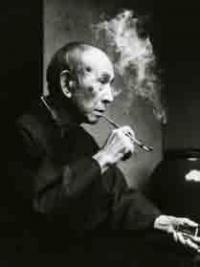 the artist in 1959 | During his career, Kondō Kōichiro practiced both Western-style painting (yōga) and traditional Japanese-style painting (nihonga), but he was, perhaps, best-known for his popular manga (cartoons), appearing in books and newspapers and as prints. Born in the village of Mutsuai (the present-day town of Nanbu), Yamanashi Prefecture, his birth name was Kondō Hiroshi 近藤浩. During his artistic career he used the gō (artist names) Kiitchō 木巾腸 and Kōichiro 浩一路. He studied Western painting at Tokyo Art School (Tokyo kijutsu gakkō, the present Tokyo University of the Arts) with Kuroda Seiki (1866-1924), a leader of the Western-style painting movement in Japan, and Wada Eisaku (1874-1959), another well known Western-style painter. After his graduation in 1910, Kondō practiced Western-style painting and drew manga and illustrations for the Yomiuri Shinbun and Asahi Shinbun newspapers. Around 1915, he joined the Sango-kai (Coral Society), an organization of |
Japanese-style painters, which counted Ikeda Eiji (1889-1950), Ogawa Usen (1868-1938), Ogawa Senyō (1882-1971), Kawabata Ryushi (1885-1966), Tsuruta Goro (1890-1969), Natori Shunsen (1886-1960), Yamamura Toyonari [also Kōka] (1885-1942)], Morita Tsunetomo (1881-1933) and Ishizuka Kan (active c. 1915) as members.1 In 1919 he started entering his distinctive Japanese-style landscape paintings in the exhibitions of the Japan Art Institute (Inten) which he later joined. He exhibited regularly in the Inten exhibitions until his resignation from the group in 1936, after which he shunned membership in any artistic group.
Kondō traveled extensively throughout Japan to capture both the scenery and lives of its people, including a 1917 trip to Hokkaido to sketch the Ainu people.2 He also traveled to China and, inspired by his teachers' travels to Europe, traveled to Europe in 1922 and to Paris in 1931. It was during the 1931 trip that he captured the attention of the French novelist André Malraux, who based the character Kama, a Japanese-style ink painter, in his 1933 novel Man's Fate ("La Condition humaine"), on Kondō.3 Malraux also helped in organizing an exhibition in Paris of Kondō's work. His trips to Europe are credited with reinforcing Kondō's "essential Japanese spirit" and to his abandoning of Western-style painting in favor of traditional Japanese-style ink painting integrated with Western pictorial techniques.4
Writing in A Dictionary of Japanese Artists, Robert's comments, "His interesting paintings, though done in ink [in the Japanese-style], have much Western feel about them and a great preoccupation with the problem of rendering light" [as can be seen in the below 1951 painting by the artist, Uki, which the Yamanashi Prefectural Museum of Art praises as "a masterpiece of Kondo's mature period...].
Manga were a major part of Kondō's artistic output and income and he went on to found the Nippon Manga-kai (Japanese Manga Society) with Naraharu Ikeda (1889-1950) and Okamoto Ippei (1886-1948), one of the forefathers of modern manga. He and Okamoto became well-known for their "manga scribblings" and with Okamoto he produced manga versions of Natsume Soseki's novels Botchan and I am a Cat, an illustration from which is shown below.

Illustration from I am a Cat
Merritt notes that he created woodblock illustrations before World War II without citing any specifics.5 We do know that he created one print (IHL Cat. #219) for the short-lived 1915 magazine Shin Nigao and at least 20 prints in a series titled Senryū manga 川柳漫画, in which Kondō's drawings are paired with Inoue Kenkabō's (1870-1934) senryū (humorous short poems).
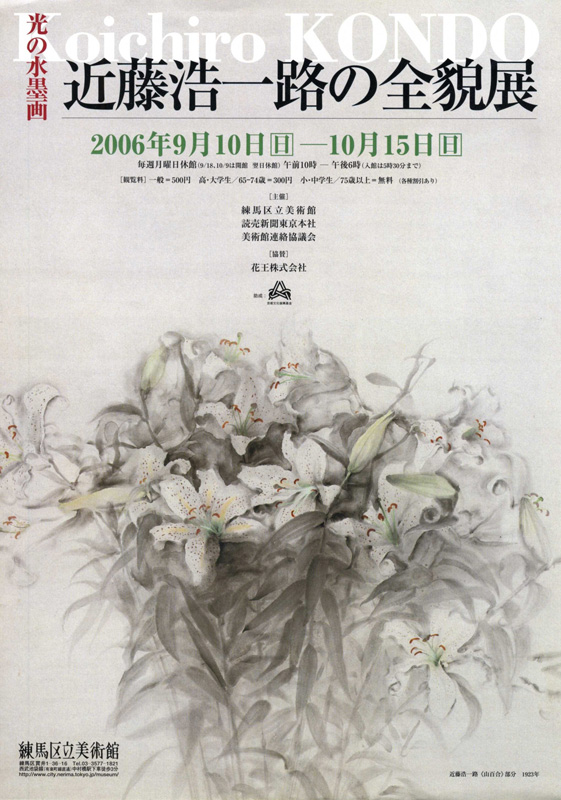
In September 2006 the Nerima Art Museum in Tokyo celebrated the 120th anniversary of Kondō Kōichiro's birth with a comprehensive exhibition, All About Kōichiro Kondō, of 120 works, including oil paintings, watercolors and cartoons.
The artist's works are in the collection of the Yamanashi Prefectural Museum of Art and the National Museum of Modern Art, Tokyo among others.
1 "Compilation of Materials Related to the Sango-kai," Kikuya Yoshia and Shioya Jun, Independent Administrative Institution National Research Institute for Cultural Properties, Tokyo http://www.tobunken.go.jp/~bijutsu/publications/bijutukenkyu/376_Sangokai.html
2 “Touring the Indigenous Village: Kondō Kōichiro’s Ainu Illustrations, 1917,” Christina Spiker
3 "The Passage to Paris and Far East Artistic Awakening through Japanese painters: Tsuguharu Léonard Foujita (1886-1968) and Koichiro Kondo (1884-1962)", Kuniko Abe, appearing in the journal AIU Global Reveiw, Volume 7, 2015, Akita International University Press [http://web.aiu.ac.jp/wp/wp-content/themes/aiu2016//doc/press/GlobalReview_2015.pdf]
4 Ibid.
5 Guide to Modern Japanese Woodblock Prints: 1900-1975, Helen Merritt, University of Hawaii Press, 1992, p. 75.
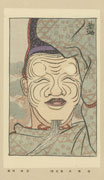
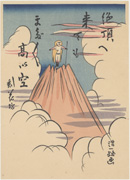

![[unread senryū] Young samurai gets a scolding from the series Senryū manga](kondo-koichiro-1884-1962/A scolding ihl cat 1560 thumb web.jpg)
![[unread senryū] Tipsy from the series Senryū manga](kondo-koichiro-1884-1962/Conversation ihl 1550 thumb web.jpg)
![[unread senryū] Encounter on a shaking train from the series Senryū manga](kondo-koichiro-1884-1962/Encounter on train ihl 1551 thumb web.jpg)
![[unread senryū] Ghost shamisen players from the series Senryū manga](kondo-koichiro-1884-1962/Ghost shamisen players ihl cat 1561 thumb web.jpg)
![[unread senryū] Senior officer gives subordinate a tongue lashing for wearing the wrong uniform from the series Senryū manga](kondo-koichiro-1884-1962/Giving orders ihl 1553 thumb web.jpg)
![[unread senryū] Man admires baby being held by its mother from the series Senryū manga](kondo-koichiro-1884-1962/Happy Baby ihl 1549 thumb web.jpg)
![[unread senryū] Bald head with a headache from the series Senryū manga](kondo-koichiro-1884-1962/Monk with headache ihl 1554 thumb web.jpg)
![[unread senryū] Morning glory from the series Senryū manga](kondo-koichiro-1884-1962/Morning glory ihl 1552 thumb web.jpg)
![[unread senryū] Stop yawning and listen to me from the series Senryū manga](kondo-koichiro-1884-1962/Not a laughing matter ihl 1555 thumb web.jpg)
![[unread senryū] Peacefully sleeping couple from the series Senryū manga](kondo-koichiro-1884-1962/Peacefully sleeping couple ihl1578 thumb web.jpg)
![[unread senryū] A big yawn finds the sacred wine from the series Senryū manga](kondo-koichiro-1884-1962/Screaming ihl cat 1557 thumb web.jpg)
![[unread senryū] Writing on a shamisen from the series Senryū manga](kondo-koichiro-1884-1962/Shamisen ihl 1556 thumb web.jpg)
![[unread senryū] Topsy-turvy in the sumo arena from the series Senryū manga](kondo-koichiro-1884-1962/Sumo wrestlers ihl 1547 thumb web.jpg)
![[unread senryū] Thief in the night from the series Senryū manga](kondo-koichiro-1884-1962/Thief ihl 1559 thumb web.jpg)
![[unread senryū] Village sumō match determined by a bee from the series Senryū manga](kondo-koichiro-1884-1962/Two persons on the sumo platf-a47cbf38904e257a.jpg)
![[unread senryū] Meditating Zen priest squashes flea from the series Senryū manga](kondo-koichiro-1884-1962/Zen Priest ihl 1558 thumb web.jpg)
![[unread senryū] Embarrassed woman from the series Senryū manga](kondo-koichiro-1884-1962/Womanwithkimonosihl2539thumbweb.jpg)
![[senryū] Buying the first bonito of the season without an abacus from the series Senryū manga](kondo-koichiro-1884-1962/runningiwthfishihl2540thumbweb.jpg)
![[untranslated senryū] Drinking sake as if it were money from the series Senryū manga](kondo-koichiro-1884-1962/spilling sakeihl2541thumbweb.jpg)
![[unread senryū] Father and son passing on the embankment from the series Senryū manga](kondo-koichiro-1884-1962/whispered meetingihl2542thumbweb.jpg)
![[untranslated senryū] Thrown down from the series Senryū manga](kondo-koichiro-1884-1962/Swordfightihl2543thumbweb.jpg)
![[unread senryū] Happy man wearing a padded haori from the series Senryū manga](kondo-koichiro-1884-1962/Mansmokingdrinkingteaihl2544thumbweb.jpg)
![[untranslated senryū] Old woman looking at a gnarled pine tree from the series Senryū manga](kondo-koichiro-1884-1962/old woman looking at knarled -a471b52828c9d4b2.jpg)
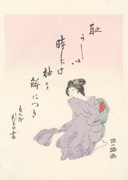
 1951 600w.jpg)